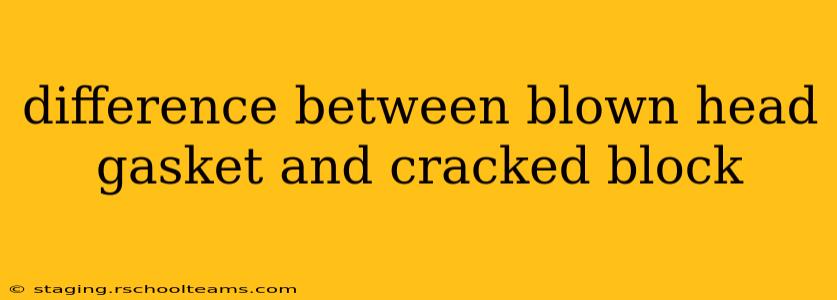Identifying the source of a coolant leak or engine overheating can be tricky. Two common culprits are a blown head gasket and a cracked engine block. While both can lead to similar symptoms, understanding their differences is crucial for accurate diagnosis and effective repair. This article will delve into the distinctions between these two significant engine problems.
What is a Blown Head Gasket?
A head gasket is a crucial component sealing the gap between the engine block and the cylinder head. It prevents coolant and oil from mixing and maintains the necessary compression in the cylinders. A blown head gasket occurs when this seal fails, leading to leaks. This failure can be caused by overheating, improper tightening during assembly, or age and wear.
Symptoms of a Blown Head Gasket:
- White smoke from the exhaust: This indicates coolant leaking into the combustion chamber.
- Coolant loss without visible leaks: Coolant is disappearing, but you can't find any external leaks.
- Oil contamination with coolant (milky oil): Coolant mixing with oil creates a milky emulsion.
- Overheating: The engine struggles to maintain its operating temperature.
- Compression loss: The engine loses power and performance due to reduced compression in one or more cylinders.
- Sweet smell from the exhaust: Coolant has a sweet smell that's often noticeable when it burns.
What is a Cracked Block?
The engine block is the main structural component of the engine, housing the cylinders and other vital parts. A cracked block refers to a fracture in the engine block itself, typically caused by extreme overheating, freezing temperatures, or external damage. These cracks can allow coolant to leak out, but they can also be much more severe, compromising engine integrity.
Symptoms of a Cracked Engine Block:
- Coolant leaks: Often accompanied by visible leaks from the engine block.
- Overheating: The engine's temperature rises rapidly and excessively.
- Loss of compression: Similar to a blown head gasket, this leads to a loss of engine power.
- External coolant leaks: You may see coolant dripping from the engine block itself, unlike the internal leaks of a blown head gasket.
- External signs of cracking: Sometimes, visual inspection might reveal cracks on the exterior of the block. This isn't always the case, especially with internal cracks.
What's the Difference Between a Blown Head Gasket and a Cracked Block?
The key differences lie in the location of the failure and the severity of the damage. A blown head gasket affects the seal between the head and block, while a cracked block involves a fracture within the engine block itself. A blown head gasket is often repairable with a replacement gasket and resurfacing, whereas a cracked block often requires significant repair or engine replacement, especially if the crack is extensive or in a critical area.
How Can I Tell the Difference?
Diagnosing the problem requires a thorough inspection. A mechanic will typically conduct a pressure test on the cooling system and perform a compression test to check for leaks and compression loss in the cylinders. In some cases, a dye test may be used to pinpoint the location of a leak. Visual inspection is important too, although internal cracks in the block may be difficult to spot without specialized equipment.
Can a Cracked Block Cause a Blown Head Gasket?
While not directly causative, extreme overheating that leads to a cracked block can also damage the head gasket. The severe thermal stress can cause the gasket to fail, often making diagnosis more complex.
Is a cracked block always fatal for the engine?
Not always. Small, superficial cracks in non-critical areas might be repairable through welding or sealing. However, larger cracks, especially those compromising the structural integrity of the block, often necessitate engine replacement.
How Much Does it Cost to Repair a Blown Head Gasket or a Cracked Block?
The repair costs vary drastically depending on the vehicle, the extent of the damage, and labor rates. A head gasket replacement is generally less expensive than a block repair or replacement. Expect to pay significantly more for block repairs or a new engine.
How can I prevent these problems?
Regular maintenance is key! This includes:
- Regular coolant flushes: Removes contaminants and prevents corrosion.
- Monitoring coolant levels: Address leaks promptly.
- Properly maintaining engine temperature: Avoid overheating.
- Regular oil changes: Ensures proper lubrication and reduces engine wear.
Understanding the differences between a blown head gasket and a cracked block is vital for timely diagnosis and effective repairs. If you suspect either problem, consult a qualified mechanic immediately to prevent further damage and costly repairs.
